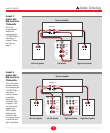
9
Model 272 PBM THX
Atlantic Technology
®
Helpful Hint: A particularly useful experiment is to place the subwoofer right at the prime listening position
(move your couch or chair out of the way and put the sub in its place). Then play something with lots of good
bass (preferably music), and walk around the room, listening to the subwoofer’s response. When you locate
an area that has ample amounts of well defined bass you’ve found a good potential place to locate the sub.
System Set Up
When setting up a complete home
theater we strongly recommend that
you use a Sound Pressure Level meter.
Radio Shack
®
has a good one that is
very affordably priced (approximately
$40). To use this meter, turn on your
system, put the Processor/Receiver in
the Test Mode and set its main volume
control to 0dB. Sit in the prime
listening position, set the SPL meter to
the 70dB scale, Slow Response, and C
Weighting. Now, holding the meter
pointed up and in front of you, let the system cycle its test tone from speaker to speaker and set every
speaker to 75dB using the individual level settings in the Processor/Receiver. As tempting as it may be
to set the subwoofer and/or surround speakers higher than 75dB, try them properly set and see if you
can acclimate to these levels. Try watching several different movies and keep in mind that the goal is
to have a system that sounds like you’re actually “in the movie.”
When using the latest discrete digital electronics which include internal level controls for all channels,
we recommend setting the subwoofer’s front mounted Level Control to its THX/Fixed position and
using the Processor/Receiver’s built-in subwoofer level control. Should you have difficulty achieving
the correct subwoofer volume this way or should your Processor/Receiver not have a subwoofer level
control, you can use the 272 PBM’s front mounted level control to make this adjustment.
If you decide not to use an SPL meter try to set all the speaker levels the same using the Test Tones. Of
course, this will be much more difficult without the meter, especially for the subwoofer.
Subwoofer Tuning Without an SPL Meter or Test Tones
Start your listening with the subwoofer Lo-pass control set at 80Hz or in the THX/Bypass position if
you’re using a THX Certified processor or unit with a built-in crossover. Set the phase switch to
normal, and the front panel variable level control (Figure 4) to the THX/Fixed position. Play some
music that you know has good bass content, and turn the level control up until
you just start to hear the subwoofer working. Now, from your normal listening
position, determine whether the subwoofer is playing loudly enough and filling
in the bass frequencies of the music evenly. If adjustment is necessary, start by
changing the setting in the processor or on of the front panel level control, if
your processor lacks a subwoofer level adjustment.
If the bass seems too ponderous, boomy, or heavy, no matter how you set the level, try moving the
subwoofer away from the wall/corner. If the bass seems too thin, try moving the subwoofer closer to
the wall/corner. Small differences in positioning can make big differences in bass response. When you
find a position that seems to work well, try switching the phase switch between its two settings,
listening particularly to the transition from the subwoofer to the satellites.
Figure 3:
Typical arrange-
ment for a single
subwoofer in a
home theater.
Start here
Less Bass
More Bass
Figure 4:
Front Panel
Variable Level
Control located
behind the
removable grille














